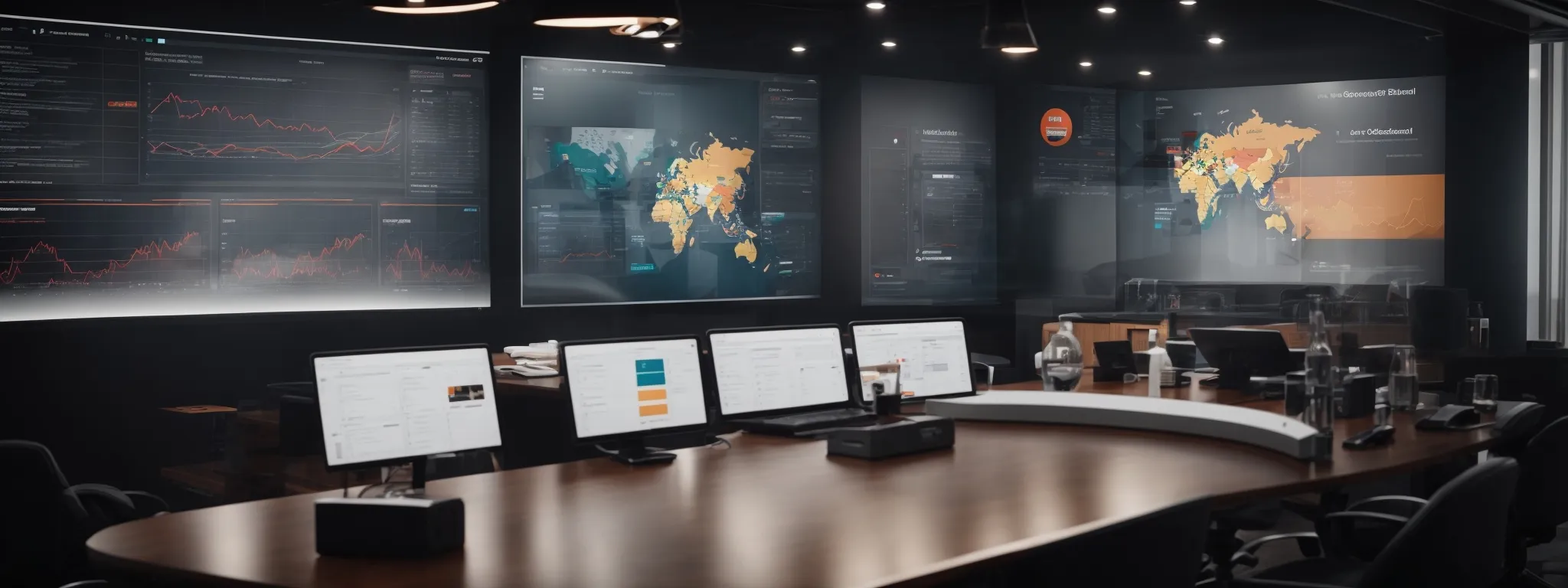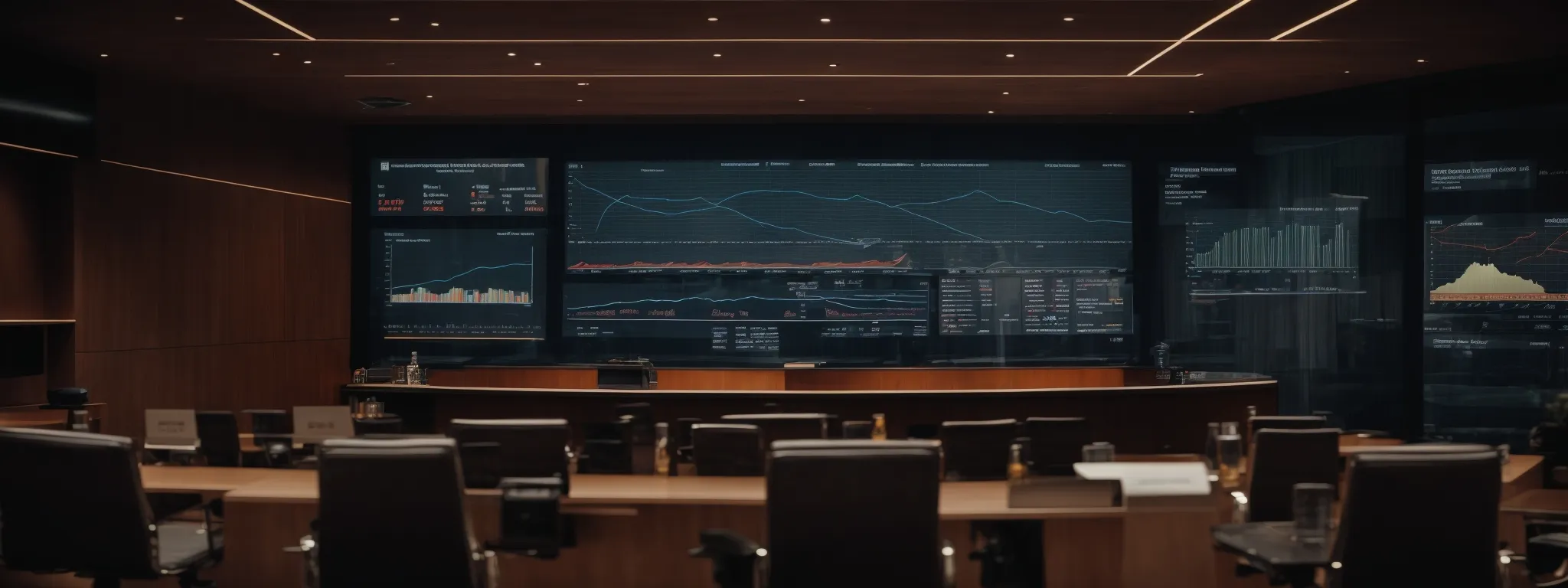B2B Marketing Attack Plan: Craft with Care
Strategic B2B Marketing: Crafting Your Attack Plan With Precision In the competitive realm of B2B marketing, precision and strategic planning are pivotal in carving a distinct presence […]
Strategic B2B Marketing: Crafting Your Attack Plan With Precision
In the competitive realm of B2B marketing, precision and strategic planning are pivotal in carving a distinct presence within niche markets.
Every B2B marketer grapples with the challenge of standing out in a landscape where personalization holds the key to unlocking business growth.
From establishing brand identity to the execution of data-driven marketing campaigns, an efficacious B2B strategy requires a nuanced approach that resonates with target audiences on multiple levels.
Crafting a comprehensive attack plan demands not only innovative agility but also an in-depth understanding of the unique dynamics that drive B2B relationships.
Keep reading to explore how meticulous planning and tactical precision underpin the success of contemporary B2B marketing initiatives.
Key Takeaways
- A Successful B2B Marketing Strategy Must Be Data-Driven and Well-Orchestrated, With Clear Goals and Performance Indicators
- Crafting an Engaging Brand Narrative and a Robust Online Presence Is Critical for B2B Companies to Stand Out in a Competitive Market
- Marketing Automation Tools Are Invaluable for Streamlining Campaigns and Nurturing Leads Efficiently in B2B Marketing
- High-Quality Visual Marketing and Content Are Essential for Fostering Brand Identity and Thought Leadership in B2B Industries
- Trade Shows and Industry Events Offer Significant Opportunities for B2B Companies to Showcase Their Expertise and Build Meaningful Connections
Charting the Course for B2B Marketing Success

In the realm of B2B marketing, success is not a product of chance but the outcome of a well-orchestrated strategy designed with precision.
As business owners and marketing teams grapple with the complexities of targeting niche markets, it becomes imperative to set clear, actionable objectives.
The initial step involves defining your strategic marketing goals, which serve as a guiding beacon for your entire campaign.
Follow this by a rigorous assessment of the competitive landscape, an exercise that unveils invaluable insights into market dynamics.
To truly gauge the impact of your marketing efforts, identifying Key Performance Indicators is critical, ensuring that every tactic not only aligns with the overall business plan but also contributes measurably to business growth.
These foundational activities set the stage for a B2B marketing strategy that navigates the competitive terrain with informed confidence.
Define Your Strategic Marketing Goals
Embarking on a B2B marketing journey requires a Clear Understanding of the Desired Destination. A business owner must pinpoint the unequivocal objectives that will drive the marketing strategies forward, be it enhancing brand awareness among b2b customers, increasing lead generation, or driving customer engagement.
Setting these goals is tantamount to charting a path through uncharted territory: it provides direction and purpose. The performance indicators, therefore, become the compass by which a B2B marketer can navigate, measure successes, and recalibrate when necessary, guaranteeing that every marketing effort propels the company towards its overarching ambitions.
Conduct a Competitive Landscape Assessment
In today’s competitive B2B landscape, conducting a robust Competitive Landscape Assessment stands as a non-negotiable for any business determined to seize market leadership. This analytical tactic involves a deep dive into the strengths, weaknesses, opportunities, and threats present within the market, enabling organizations to refine their marketing strategies with precision.
By employing comprehensive Market Analysis Tools like LinkGraph’s SearchAtlas SEO software, companies unlock a trove of data-driven insights. These insights allow marketing teams to devise high-impact marketing tactics that are responsive to the dynamics of their industry, ensuring their approach to customer acquisition is both aggressive and informed.
Identify Key Metrics for Measuring Success
In the arena of B2B marketing, the selection of pertinent metrics stands as the linchpin of any robust strategy. Metrics, or key performance indicators (KPIs), are the quantifiable signposts that marketing teams rely on to assess the efficacy of their tactics and campaigns, determining whether they hit the mark or fall short in engaging their target audiences.
Critical KPIs might include metrics such as conversion rates, which reflect the percentage of prospects that become leads, or customer lifetime value, indicating the total revenue a business can expect from a single account. These measurements serve as vital feedback mechanisms, offering clarity on the return on investment for varied marketing activities and influencing strategic decisions in real-time.
Creating a Compelling Brand Identity in B2B Markets

In the fast-paced sphere of B2B marketing, the creation of a compelling brand identity is not merely desirable—it is indispensable for standing out in a sea of competitors.
For a B2B company, constructing a brand that resonates with the target audience requires the articulation of a unique value proposition—one that encapsulates the distinct advantages the brand offers over others.
With a commitment to consistency, a robust brand messaging framework becomes the backbone of communication across all marketing channels, fortifying the brand’s narrative everywhere it’s encountered.
Positioning a brand effectively hinges on an intimate understanding of the competitive landscape, a process that turns competitors into benchmarks, against which to sharpen and contrast the brand’s unique qualities.
This strategic trifecta of brand definition, messaging, and positioning forges a powerful identity that is capable of capturing the attention and loyalty of the most discerning b2b customers.
Establish Your Unique Value Proposition
In the competitive realm of B2B commerce, the ability to articulate a unique value proposition is the cornerstone upon which the edifice of brand identity is built. This proposition must convey the specific benefits and solutions a brand provides, differentiated from the offerings of others in the marketplace.
It requires a synthesis of market savvy and creative messaging to craft a value statement that strikes a chord with b2b buyers. By honing in on the unique traits that set a business apart, a business owner can position their brand not just as a choice, but as the inevitable solution to their client’s needs:
- Understand the target market’s challenges and pain points.
- Highlight the business’s unique strengths and competitive edge.
- Communicate the distinct advantages in terms that resonate with the target audience.
Develop a Consistent Brand Messaging Framework
For B2B companies, articulating a coherent brand messaging framework stands as one of the most pivotal elements in carving out a distinct space within the market. It is this consistent narrative that provides a thread of connectivity across various marketing initiatives, enabling the brand to foster a strong and enduring association with its core values in the minds of its audience.
By meticulously defining the language, tone, and messaging pillars, a B2B organization ensures that every piece of content—from an insightful blog post to a targeted social media campaign—advances the brand’s narrative. Thus, a well-designed messaging framework not only amplifies brand recognition but also fortifies the company’s market positioning as a reliable, knowledgeable, and indispensable partner in its field.
Position Your Brand Effectively Against Competitors
Positioning a brand effectively in the B2B arena demands a keen awareness of competitor strategies and nuances. It necessitates a tactical approach: one where a business leverages the distinct characteristics and values of its brand while being acutely tuned to the competitive moves and countermoves in its industry sector.
Once this strategic distinction is understood, the business can then take proactive steps to cement its place in the market hierarchy:
- Initiate and maintain a compelling digital marketing narrative that showcases the brand’s unique selling points.
- Deploy targeted marketing campaigns that communicate the brand’s expertise and customer success stories.
- Refine SEO reputation management and link building services to enhance digital presence and authority.
Through a carefully plotted course that incorporates these systematic actions, B2B companies can not only differentiate themselves from competitors but can establish an indelible brand identity that commands respect and preference amongst their target market segments.
The Role of Creative Design in B2B Strategy

Embarking on a B2B marketing odyssey demands not only a sharp strategic mindset but also a keen eye for design that propels brand identities forward.
Within the meticulous architecture of B2B marketing, creative design emerges as a force that, when skillfully aligned with brand strategy, catalyzes recognition and preference.
It’s a potent tool that, when employed astutely, can transform static marketing materials into dynamic ambassadors for brand ethos, setting a company apart in the densely populated marketplace.
Fostering this visual harmony calls for the investment in superior quality design—investment that pays dividends by elevating a brand’s story, enhancing its professional image, and compellingly conveying its value proposition.
Align Design Elements With Brand Strategy
In the discerning world of B2B strategy, aligning design elements with overarching brand strategy is not optional—it’s imperative. Every visual aspect, from the color palette to the typography, must not only reflect but also reinforce the strategic messaging and values a business seeks to communicate.
This synergy between design and strategy serves as a beacon, guiding prospective clients through a visual journey that aligns seamlessly with the strategic narrative of the brand. Such an intentional embrace of aesthetic cohesion ensures a brand’s visual identity is an active participant in its strategic conquests, ultimately fortifying its position in the competitive B2B marketplace.
Utilize Visual Communication to Enhance Brand Recognition
Effective visual communication acts as a bridge, linking a brand’s strategic intentions with its audience’s perceptions. By leveraging visual storytelling, B2B marketers can implant their brand into the collective memory of their target market, ensuring a lasting imprint is made through strategic design choices that echo the core brand message.
Distinct graphical elements like logos, infographics, and design schematics are imperative in fostering brand recognition. They serve as visual anchors that captivate and educate the audience, translating complex B2B relations into understandable and memorable visual concepts:
- Enlist the right color schemes that coalesce with the brand’s emotions and values.
- Implement consistent design templates across marketing materials to establish visual unity.
- Design icons and imagery that convey brand attributes with immediacy and clarity.
Invest in High-Quality Design for B2B Marketing Materials
Investing in high-quality design for B2B marketing materials is far more than an exercise in aesthetics; it is a strategic imperative. It ensures that every touchpoint with potential clients reflects the refined professionalism and unique character of a business, thus reinforcing the trust and authority that are essential in B2B relationships.
The strategic deployment of superior design elevates marketing materials from mere information carriers to persuasive storytelling tools. They become the visual embodiment of the brand’s value proposition, resonating with precision and clarity in the minds of the target audience.
| Strategic Element | Design Priority | Outcome |
|---|---|---|
| Brand Identity | Consistency in Visuals | Strengthened Brand Recall |
| Value Proposition | Creative Storytelling | Enhanced Engagement |
| Client Trust | Professionalism in Design | Increased Credibility |
Leveraging Content Marketing for Thought Leadership

In an environment where establishing thought leadership has become central to B2B marketing success, content marketing stands out as a pillar for businesses aiming to demonstrate expertise and captivate their target audience.
Insightful content serves not only to inform but to address the crucial industry challenges that resonate with a B2B audience.
By implementing an editorial calendar, businesses ensure a consistent cadence of content that supports strategic marketing objectives and reinforces the brand’s position as an authority in its niche.
This consistency in publishing authoritative content aids in fortifying trust and fostering a deeper connection with current and prospective clients.
Generate Insightful B2B Content Ideas
In the arena of B2B content marketing, generating insightful ideas is akin to discovering unmined diamonds in the rough. These ideas must enlighten the target audience, sparking genuine interest and discussion within the B2B community, thereby establishing the company’s reputation as a thought leader.
With focus and precision, marketing teams tap into industry pain points, deploying resources like SearchAtlas SEO software to unearth topics that resonate deeply with the target audience. Content creation then transforms these insights into compelling narratives, elegantly positioning the company as both an expert and innovator in their field.
Craft Content That Speaks to Industry Pain Points
In the competitive theater of B2B marketing, addressing industry pain points through content establishes a business as a beacon of expertise. Adeptly crafting content that identifies and offers solutions to these challenges fosters an image of the business as an indispensable resource, a luminary in a field hungry for actionable insights and leadership.
A harmonious blend of the SEO content assistant and in-depth industry knowledge allows companies to shape content that not only generates interest but also triggers meaningful discourse. By pinpointing the exact tribulations that plague their audience, brands wield the power to curate content with unrivaled relevance, solidifying their stature as trusted advisers in the B2B sphere.
Implement an Editorial Calendar for Consistent Publishing
In the rigorous domain of B2B marketing, the deployment of an editorial calendar is a strategic maneuver that ensures a systematic and sustained release of content. Such a calendar enables businesses to plan their content marketing strategy with military precision, guaranteeing that each piece aligns with strategic marketing efforts and solidifies their reputation as thought leaders.
Adherence to a meticulously structured editorial schedule prevents gaps in communication, ensuring that the target audience receives a continuous stream of insightful content. This methodical approach to publishing not only enhances brand visibility but also establishes a rhythm that clients and B2B buyers can come to expect and trust.
Maximizing Publicity Through Strategic B2B Outreach

In the meticulously constructed theater of B2B marketing, a nuanced approach to outreach can dramatically enhance a brand’s visibility and foster influential connections.
Strategic outreach is not a matter of serendipitous engagement but a calculated endeavor where identifying key influencers and decision-makers paves the way for poised interactions that can alter the course of a brand’s narrative.
By crafting a B2B public relations plan tailored to the intricacies of the industry, businesses prepare to launch a barrage of optimized press releases and finely tuned media pitches.
This proactive and focused advance shapes the dialogue within the sector, capturing the attention of thought leaders and providing a catapult for the brand to secure its place in the vanguard of industry conversation.
Identify Influencers and Decision Makers in Your Industry
In the interconnected world of B2B marketing, identifying the right influencers and decision makers is akin to assembling a tactical strike team: precision is paramount. It requires organizations to engage in meticulous research and social listening to pinpoint those individuals who wield significant sway within the industry.
The targeted approach to influencer identification involves mapping out the network of professionals who not only understand the niche market but can also amplify a brand’s message with authority. Engaging with these pivotal players can transform a business’s outreach from a mere whisper in the marketplace to a resonant clarion call:
| Strategic Objective | Key Players | Expected Impact |
|---|---|---|
| Enhance Brand Visibility | Influencers with Industry Clout | Amplified Messaging and Credibility |
| Drive Thought Leadership | Decision Makers with Market Influence | Elevated Industry Standing and Connections |
Create a B2B Public Relations Plan
A Meticulously Constructed B2B Public Relations Plan serves as the keystone in a business’s strategic edifice for marketing communications. By aligning PR initiatives with the business’s core objectives and audience preferences, the plan ensures coherence and precision in every public interaction, striving to garner media attention and establish credibility in the B2B marketplace.
Execution of this plan hinges on crafting compelling narratives that resonate with the brand’s corporate identity and articulating these messages across select channels. Through this endeavor, an organization positions itself to cut through the noise, attract positive media coverage, and build relationships with industry pundits, aiding not just in brand outreach, but in sculpting its public perception.
Optimize Press Releases and Media Pitches
In the sphere of B2B marketing, the optimization of press releases and media pitches can be likened to sharpening arrows for a precise flight path. To this end, companies refine their messaging, ensuring it is tailored to the nuances of their target audience while embedding strategic keywords to enhance visibility and search engine relevance.
Strategic dissemination of media pitches supports the creation of a tightly woven narrative that entrenches a brand’s reputation as an industry leader. This involves choosing the right media channels and timing for release, which aims to capture the peak moments of engagement within the business community and media cycles.
Research & Analysis: The Foundation of B2B Strategy

Navigating the complex labyrinth of B2B marketing necessitates far more than mere intuition; it requires a robust foundation built upon targeted research and rigorous analysis.
As the bedrock of a strategic marketing attack plan, the procurement and examination of market insights empower businesses with the clairvoyance to orchestrate data-driven decisions.
In an ecosystem where precision and adaptation are key, refining an approach on the anvil of analytical findings ensures strategies are continuously sharpened, targeted and, ultimately, successful in their objective.
Within this critical phase of strategy development, it’s the integration and application of market intelligence that primes a B2B initiative for a surgical strike in the corporate arena.
Gather Actionable B2B Market Insights
Unearthing actionable B2B market insights is the linchpin of strategic marketing, providing the actionable data that steers decision-making in a landscape marked by competition and complexity. Through the meticulous collection and analysis of data, businesses can anticipate market trends, understand customers’ evolving needs, and tailor their marketing strategies to meet these demands effectively.
Accurate market insights offer a clear vantage point from which businesses can craft targeted campaigns and showcase their proficiency to the right audience at the opportune time. LinkGraph’s SearchAtlas SEO software, for example, equips B2B marketers with a robust suite of analytics and tracking tools that shed light on the customer journey, harnessing critical data points to fine-tune messaging and maximize campaign impact:
| Insight Category | Tool Utilized | Strategic Benefit |
|---|---|---|
| Customer Journey Analysis | LinkGraph’s SearchAtlas | Enhanced Understanding of Buyer Behaviors |
| Market Trend Forecasting | SearchAtlas SEO Software | Proactive Campaign Strategy Adaptation |
| Competitive Positioning | LinkGraph’s Analytics Suite | Refined Messaging for Targeted Impact |
Employ Data-Driven Decision Making
Embracing Data-Driven Decision-Making propels B2B companies into the stratosphere of strategic precision, equipping them with the insights necessary to execute their marketing campaigns with laser-focused accuracy. Utilizing platforms like LinkGraph’s SearchAtlas, marketers can distill vast quantities of performance data into actionable intelligence, shaping campaigns that precisely target and resonate with their desired audience.
By employing rigorous data analytics, B2B marketing professionals can pivot and adapt swiftly to the shifting tides of market conditions, ensuring their strategies stay relevant and impactful. Armed with the power of data, these marketers forge a competitive edge by continually refining their approach, which leads to improved outcomes and optimized return on investment for their marketing efforts.
Refine Your Attack Plan Based on Analytical Findings
Armed with the insights garnered from comprehensive analytics, B2B marketers refine their strategic attack plan, adapting methodologies in real-time to navigate the competitive marketscape. Adjustments are made not on whims but on the back of empirical evidence, ensuring strategies are as potent and precise as the desired outcomes they seek to achieve.
The fusion of LinkGraph’s SearchAtlas SEO software with a marketer’s expertise enables seamless integration of analytical findings into the planning process. This approach transforms raw data into strategic adjustments, optimizing each marketing move to align tightly with evolving market trends and customer behavior patterns.
Cultivating B2B Relationships With Social Media Strategy

In today’s digital-first landscape, the strategic use of social media in B2B marketing has become a linchpin for establishing robust relationships and fostering engaging conversations with business audiences.
A nuanced social media strategy empowers B2B companies to reach decision-makers through the platforms where they spend significant time seeking insights and networking with peers.
By meticulously selecting the most effective social media platforms, crafting a content calendar that addresses the specific interests and needs of a B2B audience, and closely monitoring the impact of social media engagements, businesses can calibrate their tactics to optimize results.
This diligent approach to social media management constitutes an essential segment of a B2B marketer’s arsenal, driving visibility, and reinforcing connections with the ultimate aim of achieving strategic marketing objectives.
Choose the Right Platforms for B2B Engagement
In the intricately woven tapestry of B2B marketing, selecting appropriate social media platforms is essential for nurturing professional relationships. Each platform offers a different dynamic and potential for reach, making the strategic choice a critical step in connecting with a precise target audience where they are most active and open to engagement.
For B2B marketers aiming at sustained engagement and deepened business relationships, it’s vital to prioritize social media channels that mirror the professional tone and networking nature of their clients. This focused approach ensures that the content reaches the right decision-makers and influencers, fostering valuable interactions that are aligned with business objectives and the distinct culture of each social platform.
Develop a Content Calendar Tailored to B2B Audiences
Developing a content calendar specifically for B2B audiences is the linchpin for maintaining a steady flow of impactful communication that aligns with strategic business goals. It necessitates not only understanding the cyclical nature of the B2B landscape but also the precise timing for content delivery that correlates with industry events, fiscal cycles, and decision-making periods within targeted organizations.
When B2B companies craft their content schedules, they prioritize relevance and resonance, timing articles, blog posts, and case studies to coincide with the moments their audience is most receptive. This conscientious mapping out of content ensures a company remains at the forefront of its audience’s minds, reinforcing the narrative that theirs is the brand synonymous with thought leadership and trusted solutions.
Measure Social Media Impact and Refine Tactics Accordingly
Measuring the impact of social media within a B2B context is an essential element of a finely-tuned marketing strategy. B2B marketers scrutinize engagement metrics, lead generation data, and conversion rates, using these figures to gauge the effectiveness of social media efforts in achieving business objectives.
Refining social media tactics is an ongoing process that responds to the insights drawn from performance analysis. Marketers adjust their strategies to deepen engagement, improve content relevance, and enhance lead quality, ensuring that each social media activity is precisely tailored to the business’s goals and audience needs.
Digital Marketing Tactics for a B2B Attack Plan

In the highly competitive sphere of B2B marketing, embracing the right digital marketing tactics is paramount to crafting a successful attack plan.
The ability to convert a corporate website into a powerful lead generation engine, the precision of targeted email campaigns that resonate with B2B prospects, and the strategic application of SEO to draw in high-quality traffic, all coalesce to form the vanguard of a formidable B2B marketing strategy.
Each component is meticulously designed to engage the modern buyer, crafting a pathway that leads prospects through the nuances of the B2B purchasing process with unmatched precision and efficiency.
Optimize Your B2B Website for Lead Generation
Optimizing a B2B website for lead generation is a critical move that transforms a virtual presence into a proactive business development tool. By incorporating strategic elements such as clear calls-to-action, seamless navigation, and lead capture forms tailored to the needs of a discerning business audience, companies can effectively harness their online platform to fuel their sales pipeline.
An effectively optimized B2B website goes beyond mere aesthetics, integrating robust SEO practices that enable the company to capture organic traffic with high conversion potential. Leveraging these SEO tactics, such as keyword optimization and high-quality content creation, ensures that the website not only attracts the right kind of visitors but also engages and converts them into leads.
Execute Targeted Email Campaigns for B2B Prospects
Targeted email campaigns emerge as a quintessential strategy for B2B entities keen on directly reaching their prospects with tailored communications. This precision targeting harnesses the power of segmentation, ensuring that messages resonate directly with the specific needs and profiles of potential clients, thereby fostering higher engagement rates and enhancing the possibility of conversion.
Employing targeted email campaigns allows B2B marketers to nurture leads through personalized content, delivering information that addresses the unique pain points and interests of each recipient. The strategic use of email as a direct marketing channel opens the door for ongoing dialogue, paving the way for deeper business relationships and a higher likelihood of securing client commitment.
Employ SEO Practices to Attract Quality B2B Traffic
In the strategic matrix of B2B marketing, effective employment of SEO practices serves as the magnetic pull that attracts quality traffic to a business’s digital doorstep. By optimizing website content with industry-specific keywords and creating a mesh of authoritative backlinks, businesses increase their visibility on search engines, which is imperative to capturing the interest of B2B prospects actively seeking solutions.
SEO efficiency in the B2B realm is not a mere function of chance; it relies on meticulously crafted content that speaks the language of search engines while resonating with the needs of a business clientele. Incorporating on-page and off-page SEO techniques ensures that a company’s message reaches its target audience with precision and relevance:
- Implementing tactical on-page SEO optimizations that correlate with the search behavior of business buyers.
- Building a network of quality backlinks that fortifies the business’s domain authority and market stature.
- Optimizing technical SEO to facilitate seamless site crawling and indexing, enhancing overall user experience.
Event Planning & Management as B2B Marketing Tools

In the intricate dance of B2B marketing, events present a stage for businesses to showcase their expertise, solidify their brand presence, and engage directly with peers and prospective clients.
Effective event planning and management are crucial in curating opportunities that not only capture attention but also build meaningful connections.
As companies strategize their involvement in industry events, they lay the groundwork for showcasing thought leadership through webinars and workshops.
These platforms serve as conduits for knowledge exchange, allowing businesses to underscore their expertise.
Concurrently, these events must be a reflection of the company’s core values, ensuring every encounter resonates with the brand’s promise and identity.
Such meticulous orchestration of event-driven marketing tools becomes a vital cog in the mechanics of a comprehensive B2B marketing strategy.
Strategize Your Presence at Industry Events
Strategizing your presence at industry events is a calculated endeavor, essential for B2B marketing teams aiming to amplify their brand and forge valuable connections. Crafting an event strategy demands an understanding of the target audience’s interests and the company’s capacity to engage and influence at these gatherings.
Success relies on selecting the right events that align with strategic marketing goals and carefully planning participation to optimize networking opportunities. Whether through speaking engagements, sponsorships, or exhibition booths, businesses must ensure every activity is purposefully designed to leave a lasting impact on potential clients and industry peers:
| Marketing Goal | Event Activity | Desired Outcome |
|---|---|---|
| Brand Visibility | Keynote Speaking | Position as Industry Leader |
| Lead Generation | Exhibition Booth | Direct Engagement with Prospects |
| Relationship Building | Networking Sessions | Establish Meaningful Connections |
Host Webinars and Workshops to Demonstrate Expertise
Webinars and workshops serve as powerful platforms for B2B companies to assert their thought leadership and display their depth of knowledge. By engaging directly with a targeted audience, these events enable businesses to not only showcase their expertise but also to discuss industry trends and solutions in a live forum.
The interactive nature of webinars and workshops facilitates valuable dialogue between the business and its prospects, building credibility and demonstrating a commitment to supporting industry education and advancement. This level of engagement often translates into heightened trust and stronger professional relationships:
| Engagement Type | Objective | Strategic Advantage |
|---|---|---|
| Hosted Webinars | Demonstrate Expertise | Credits the Company as an Industry Thought Leader |
| Interactive Workshops | Facilitate Dialogue | Encourages Trust and Relationship Building |
Create an Experience That Reflects Your B2B Brand Values
In B2B marketing, the careful orchestration of events is pivotal for broadcasting a brand’s core values effectively to its clientele. Ensuring every interaction, whether through immersive product demonstrations or insightful panel discussions, reflects the company’s commitment to innovation, quality, and customer service solidifies the brand’s image and strengthens its market position.
It is through these curated experiences that a business solidifies its narrative, affirming its brand values within its target market. The meticulous alignment of event themes with the brand’s ethos ensures that each attendee walks away with a memorable impression, synonymous with the company’s value proposition and strategic vision.
From Packaging to Presentation: B2B Marketing Collateral

In the meticulously crafted ballet of B2B marketing, every material a company disseminates serves as a tangible touchpoint that may tilt the scales of client opinion and decision-making.
This is why the conception of marketing collateral must go beyond mere visual appeal, embodying the strategic messaging and catered solutions that resonate deeply with B2B clients’ complex needs.
From the structural design of packaging that communicates a brand’s attention to detail, to achieving a harmonious brand language across all collateral, each asset must be leveraged to bolster sales and overall marketing momentum.
This approach treats collateral as an invaluable companion to sales and marketing efforts, ensuring that every brochure, data sheet, and business card functions as a silent yet persuasive salesman in the strategic conquest of the B2B marketplace.
Design Packaging That Speaks to B2B Clients’ Needs
In the sophisticated theatre of B2B marketing, design packaging must do more than protect a product; it must communicate a brand’s acumen and commitment to quality. Tailored to meet the discerning requirements of business clients, successful packaging design conveys a product’s value proposition and the brand’s dedication to meeting the intricate needs of its B2B customers.
Understanding the nuances of B2B customer expectations allows companies to create packaging that not only shines on a logistical level but also resonates on a strategic one. The packaging becomes a visual handshake, a first impression steeped in strategic significance, which, when expertly executed, can fortify relationships and instill confidence in the integrity and professionalism of the business offering.
Ensure Consistency Across All Marketing Collateral
In the sophisticated world of B2B marketing, ensuring consistency across all marketing collateral is not merely a matter of visual aesthetics, it’s a strategic imperative. Uniformity in design, tone, and message across various assets reaffirms the brand’s identity and solidifies its narrative in the collective psyche of its target audience.
A coherent brand story, articulated through marketing materials, serves as the silent yet compelling ambassador to a company’s ethos and strategic vision. This steadfast consistency accelerates trust-building with potential clients, paving a smoother path for the sales team as they navigate the complexities of the B2B landscape:
- Design collateral that mirrors the brand’s core messaging and aesthetics.
- Develop a succinct, recognizable voice across all materials, from brochures to digital content.
- Align marketing collateral with strategic business objectives to ensure a cohesive brand experience.
Utilize Collateral to Support Sales and Marketing Efforts
In the intricate tableau of B2B marketing, marketing collateral is employed as a strategic extension of sales and marketing initiatives. When sales representatives present well-designed brochures or case studies, they are effectively supplementing their pitches with visuals and narratives that drive the brand’s strategic message home.
Marketing collateral, when utilized effectively, functions as an anchor during negotiations and discussions, reiterating a company’s value proposition and expertise. These materials often remain with potential clients, serving as tangible reminders and influencers long after initial interactions have concluded, subtly nurturing leads towards conversion.
Technical Communications: Conveying Complexity With Clarity in B2B

In the intricate realm of B2B marketing, the art of translating complex technical details into clear, coherent communications is an invaluable skill.
As every facet of the strategy coalesces to form a unified battlefront, the creation and dissemination of technical content that educates is crucial.
It arms stakeholders with knowledge, enabling informed decision-making across various levels of an organization.
Successful B2B marketing demands this deft balancing act: tailoring technical messages to the receptive frequencies of distinct stakeholders, while seamlessly weaving these communications into the broader fabric of the strategic marketing plan.
Develop Technical Content That Educates Your B2B Audience
In the intricate domain of B2B marketing, the dissemination of technical content plays a pivotal role in underpinning a brand’s expertise. This form of content communication approaches complexity not as a barrier, but as an opportunity to enlighten a well-informed audience, fostering a deeper understanding of a brand’s products and services.
Technical content tailored for B2B channels should offer clarity and value, breaking down esoteric concepts into digestible insights that drive informed decision-making. Conveying this intricate information with precision not only positions a brand as an industry authority but also equips B2B customers with the necessary knowledge to confidently navigate their purchasing journey.
Tailor Technical Messages for Different Stakeholders
In B2B marketing, the sophistication of technical communications can often be a double-edged sword: while expertise showcases competency, it must also be accessible to stakeholders across all levels. Crafting tailored messages demands an acute understanding of each stakeholder’s knowledge base and interests, providing comprehensive, yet comprehensible, information that facilitates entity-wide endorsement and adoption.
The diversity of a B2B audience—from the C-suite executive seeking big-picture relevance to the hands-on technical professional requiring intricate detail—necessitates precisely calibrated communication. A strategy that partitions technical discourse to match the linguistic and conceptual preferences of various stakeholders ensures that each message resonates, fostering a seamless integration of complex information into strategic business decisions:
| Stakeholder | Communication Focus | Desired Understanding |
|---|---|---|
| Executives | Strategic Relevance | How it impacts business objectives |
| Technical Professionals | Granular Details | How it functions within the system |
| Sales & Marketing Teams | Value Proposition & USPs | How to communicate benefits to customers |
Integrate Technical Communications Within Your Broader Strategy
In the landscape of B2B marketing where decision layers are complex and stakeholder involvement is high, integrating technical communications into the broader marketing strategy becomes a pivotal maneuver. It ensures that every technical datum is skillfully aligned with the overall narrative, reinforcing the strategic marketing objectives while enhancing the brand’s credibility.
As B2B marketers weave technical narratives into their campaigns, they translate detailed specifications and data into compelling stories that align with branding, sales enablement, and customer education initiatives. This holistic approach guarantees that technical communications do not exist in isolation but serve as critical components that support and drive the overarching strategic marketing vision.
Making an Impact at Trade Shows With a Precision Attack Plan

Trade shows stand as commanding battlegrounds in the theater of B2B marketing, where presence, influence, and engagement converge to shape future business relationships and opportunities.
The caliber of an organization’s participation can significantly sway potential clients and partnerships, making meticulous preparation essential for making a pronounced impact.
From the ingenuity of booth design that magnetizes visitors to the finesse in crafting resonant messaging, a company’s strategy at these events is a multifaceted operation.
Training the team to engage with a highly specialized audience and cultivating these connections through diligent follow-up post-event are equally critical chapters in the saga of converting leads into tangible sales.
Enacting such a precision attack plan at a trade show is often a decisive test in a company’s strategic marketing repertoire.
Prepare a High-Impact Booth Design and Messaging
At the epicenter of trade show influence lies the power of an intelligently designed booth that speaks to the core of a brand’s strategic intent. In this bustling arena, it’s imperative that a company’s booth and messaging synergize, broadcasting a compelling story to captivate a discerning audience with decisiveness and flair.
The booth serves not only as a physical embodiment of a company’s brand but also as a beacon, drawing in targeted prospects through high-impact visuals and succinct messaging that delivers the company’s value proposition with precision and clarity:
| Booth Element | Strategic Function | Impact |
|---|---|---|
| Design Aesthetics | Capture Attention | Immediate Visual Interest |
| Core Messaging | Communicate Value | Clear Articulation of Brand Proposition |
| Interactive Displays | Engage Visitors | Deepened Interest and Engagement |
Every aspect, from the color scheme to multimedia presentations, must be orchestrated to create an immersive experience that transforms booth encounters into productive conversations, setting the stage for robust lead generation and conversion opportunities.
Train Your Team to Engage Effectively With B2B Visitors
At trade shows, the human element is paramount, and the ability for a team to engage with B2B visitors can make or break opportunities for deepening business relationships. Training your representatives becomes a business imperative, equipping them with the knowledge and skills to converse confidently about the brand’s value proposition and solutions.
Instilling an understanding of the particular interests and pain points of the target market enables team members to tailor conversations, creating impactful and meaningful interactions. This focus on engagement quality fosters a memorable brand experience, laying the groundwork for solid business connections and future dialogues.
Follow Up Post-Event to Convert Leads Into Sales
Efficient post-event follow-up is the linchpin in transforming trade show leads into successful B2B sales. A company’s strategy must extend beyond the trade show floor, employing a structured follow-up process that promptly re-engages leads with personalized communication:
| Follow-Up Action | Objective | Impact |
|---|---|---|
| Personalized Emails | Reiterate Interest | Reinforce Brand Recall |
| Targeted Calls | Deepen Conversations | Enhance Relationship Building |
| Immediate Engagement | Seize Momentum | Increased Likelihood of Conversion |
Such a deliberate tactic ensures the momentum gained during the event is not lost and that every potential client or partner receives due attention, thus maximizing the opportunity for conversion and reinforcing strategic B2B marketing objectives.
Visual Marketing: Capturing the B2B Audience’s Attention

In the distinguished arena of B2B marketing, commanding the attention of a business-minded audience demands an approach that transcends conventional text-heavy communications.
Savvy marketing teams understand that visual marketing is an incontrovertible avenue for captivating this discerning crowd.
Artfully executed visual storytelling further breathes life into a B2B brand narrative, often rendering it more memorable.
While infographics distill multifaceted data into an accessible format, enticing decision-makers to grasp the heart of the message, video content stands as a dynamic medium that garners prolonged engagement from stakeholders.
Each of these visual tactics is a vital chess piece in the grand strategy of B2B marketing, effectively besieging the barriers to attention and comprehension in a competitive marketplace.
Implement Visual Storytelling to Convey B2B Brand Narratives
Visual storytelling serves as a compelling conduit for B2B brands to communicate their narratives, as it entwines the richness of imagery with the power of narrative to deliver a brand’s message. Engaging decision-makers in a visual dialogue, these storytelling techniques encapsulate brand values, mission statements, and complex solution offerings in an attractive and easily digestible format.
The strategic integration of visual elements into the brand’s communication framework not only captures attention but also reinforces memory retention among its B2B audience. This effective merging of visual cues with core messaging guides stakeholders through the brand’s journey, fostering a deeper emotional connection and enhancing comprehension of its unique value proposition:
- Illustrate the brand’s historical milestones and evolution.
- Depict the brand’s solutions tackling industry pain points.
- Reinforce the brand’s commitment to innovation through dynamic visuals.
Use Infographics to Simplify Complex B2B Data
Infographics serve as linchpins in B2B communication, distilling intricate datasets into a streamlined visual experience that speaks clearly to business decision-makers. By transforming complex statistics and high-level analytical data into engaging graphic representations, they provide at-a-glance understanding that supports swift and informed business decision-making.
Within the B2B realm, where time is often equated with value, infographics offer a rapid route to comprehension, facilitating deeper penetration of a brand’s strategic messages. Clarity achieved through these visuals empowers businesses to captivate their audience’s attention, ensuring that critical data is not only seen but absorbed and appreciated for its significance in driving industry conversations.
Create Video Content to Engage B2B Decision Makers
Creating video content stands as a formidable tactic in the strategic B2B battlefield, engaging decision makers with a medium that is both informative and enthralling. These videos have the potential to showcase a brand’s innovative solutions and industry authority through compelling narratives that resonate with the boardroom audience.
By offering a platform for live demonstrations, testimonials, and the dramatization of success stories, videos have become essential tools in the B2B marketer’s arsenal for capturing the attention of busy professionals:
- Illustrating complex solutions through animated explainer videos.
- Building credibility with customer testimonials and case study presentations.
- Sharing expert interviews to highlight industry thought leadership.
Web Presence Optimization for B2B Engagement

In the sophisticated tapestry of strategic B2B marketing, a robust web presence is an indispensable facet of an overarching attack plan.
As the digital storefront to any organization, a well-optimized website serves not only as the initial touchpoint for engagement but also as a pivotal conversion catalyst.
It’s essential for businesses to design a user-friendly interface tailored to the professional sensibilities of their B2B audience, ensuring each visit maximizes the potential for lead generation and advancement through the sales funnel.
Meticulous attention to content alignment with B2B standards, coupled with rigorous A/B testing and analytics, refines the web experience into a precise instrument of business growth and client engagement.
Design a User-Friendly B2B Website Interface
In the digital age where first impressions are often virtual, a user-friendly interface on a B2B website is paramount. It speaks volumes about a company’s professionalism and attention to the unique requirements of their business clientele.
Empowering users with intuitive navigation and clear, accessible content structures ensures they find the information they seek without friction, facilitating a seamless interaction with the brand’s digital presence and reinforcing their position as a customer-centric, detail-oriented entity.
Ensure Content Meets B2B Professional Standards
In the strategic domain of B2B marketing, the caliber of content published on a business’s website directly mirrors the company’s professionalism. It is essential that the material not only adheres to the elevated B2B professional standards but also resonates with the sophisticated vernacular of a discerning business audience.
Maintaining an unwavering commitment to quality, accuracy, and relevance in web content is not a mere courtesy—it is a non-negotiable standard in B2B engagement. Marketers must craft content that is impressively researched, impeccably written, and flawlessly presented, offering clarity and value that affirms the business as a trusted industry authority.
Maximize Conversions With a/B Testing and Analytics
The pursuit of maximum conversions on a B2B website hinges on the strategic use of A/B testing and analytics. Through systematic experimentation with A/B testing, marketers can identify the most effective elements of a webpage that drive user action, whether it’s a change in button color, a different call-to-action phrase, or the placement of customer testimonials.
Analytics serve as the compass guiding these testing efforts, providing clear insights into user behavior and conversion metrics. With the power of data analytics, B2B marketing teams can understand the nuances of their audience’s journey, optimizing each aspect of their web presence for peak performance and superior conversion rates:
| Website Element | Variant A | Variant B | Conversion Impact |
|---|---|---|---|
| Call-to-Action Placement | Below Fold | Above Fold | Increased Visibility and Clicks |
| Testimonial Display | Text-Only | Video Format | Enhanced Credibility and Engagement |
| Color Scheme | Conservative Blue | Energetic Orange | Heightened User Interest and Interaction |
Streamlining B2B Marketing Efforts With Automation

In the highly tactical world of B2B marketing, the ability to streamline efforts through automation represents a game-changing strategy.
The embrace of sophisticated marketing automation tools allows B2B companies to execute complex campaigns with unprecedented efficiency, targeting and nurturing leads with a level of precision that manual processes simply cannot match.
By implementing lead scoring systems and nurturing workflows, businesses can optimize the buyer’s journey, ensuring that every interaction adds value and drives forward momentum.
As these systems accumulate data, the continuous analysis of automation results becomes a mission-critical task, offering strategic insights that refine and elevate B2B campaigns to new heights of effectiveness.
Choose the Right Marketing Automation Tools for B2B
In the strategic amphitheater of B2B marketing, selecting the appropriate marketing automation tools is akin to choosing the right weaponry for the battlefield. These tools must be capable of seamlessly integrating into the existing marketing infrastructure, enhancing campaign delivery and lead management processes with refined precision and intelligence.
A business embarks on the pathway to marketing efficiency when it aligns technology with its core marketing strategy. The ideal marketing automation suite for a B2B company is one that not only streamlines mundane tasks but also offers insights and enhances engagement with key decision-makers in the target market.
Set Up Lead Scoring and Nurturing Workflows
Establishing lead scoring and nurturing workflows is essential for B2B enterprises seeking to optimize their marketing funnel. By assigning scores based on predetermined criteria, companies prioritize leads, focusing their efforts on individuals most likely to convert, thereby bolstering the efficiency of sales engagements and ensuring a streamlined nurturing process.
The implementation of nurturing workflows allows a continuous and automated engagement with prospects. This strategic approach ensures that valuable content and communications are delivered to potential clients at critical points in their decision-making journey, gently guiding them toward a successful sales conversion.
Analyze Automation Results to Improve B2B Campaigns
Analyzing the results of marketing automation plays a crucial role in refining the trajectory of B2B campaigns. It empowers organizations to dissect and understand the efficacy of every automated touchpoint, from email open rates to content downloads, providing a clear picture of what resonates with their audience.
Organizations can leverage this granular data to adjust their marketing strategies, ensuring that future automation efforts are more aligned with the behaviors and preferences of their target market. This continuous loop of analysis and enhancement drives the evolution of B2B marketing campaigns toward increased precision and higher conversion rates.
Conclusion
Strategic B2B marketing is the cornerstone of commercial success in the business-to-business arena.
The crafting of a meticulous attack plan, underscored by a robust strategy, is imperative for capturing targeted markets with precision.
Businesses must define their marketing goals, assess competitive landscapes, and identify key performance indicators to ensure that every tactic significantly contributes to growth.
An effective strategy also encompasses a compelling brand identity, employing clear value propositions, consistent messaging, and a judicious brand positioning against competitors.
Investment in creative design and insightful content is vital in establishing thought leadership and reinforcing brand narratives.
The strategic use of social media, optimization of digital marketing tactics, and event management bolster brand visibility and lead generation.
A calculated approach to trade show participation and the integration of a strong web presence further enhance engagement with key decision-makers.
Marketing success in the B2B space hinges on the execution of a precision-driven plan that melds market insights with creativity, leveraging tools such as automation to streamline efforts and maximize impact.
Overall, a well-orchestrated B2B marketing strategy is paramount for navigating the complexities of the industry and achieving a sustainable competitive advantage.















































































